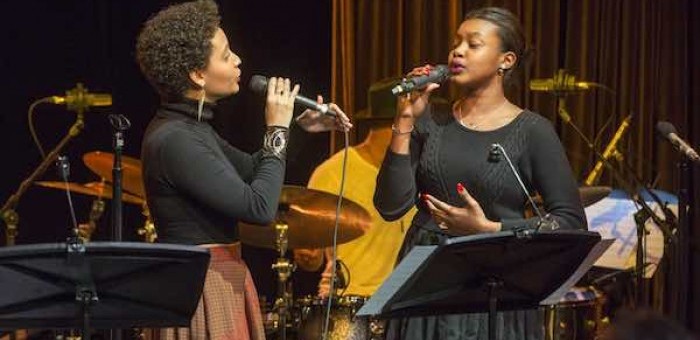Dec 9, 2025 12:28 PM
In Memoriam: Gordon Goodwin, 1954–2025
Gordon Goodwin, an award-winning saxophonist, pianist, bandleader, composer and arranger, died Dec. 8 in Los Angeles.…

Sarah Elizabeth Charles (left) sings a duet with high school student Hannah Coleman during a performance at the Harlem Stage Gatehouse in New York on Feb. 24.
(Photo: Richard Termine)Forty-five minutes before showtime, fans were already lined up for vocalist Sarah Elizabeth Charles’s Neighborhood Concert at Harlem Stage Gatehouse in New York. It’s a special venue—historic, like a small castle—with a pretty theater atop several flights of stairs.
Since October, Charles has been teaching songwriting to some of the Harlem’s talented high school students as part of Carnegie Hall Youth Programs. Three of the students’ songs would appear on the bill of Charles’ Feb. 24 performance, at which the young writers sat together, buzzing with anticipation, near the stage.
The program also featured two songs written by men incarcerated at Sing Sing Correctional Facility, another teaching venue for Charles. In a touching gesture, she invited family members of the imprisoned men to attend the performance.
Charles, an ascending vocalist in the jazz and soul world, is part of the Somewhere Project, a Carnegie Hall Weill Music Institute program that encourages musical engagement in public schools and other citywide institutions. The program, which takes its name from the song “Somewhere” in West Side Story, challenges the students to write their own “Somewhere”-inspired songs.
In performance, Charles, a vocalist of impeccable diction and near-flawless pitch, balances thoughtfulness with moments of musicality, pure energy and release. At the Harlem Gatehouse, she shared some of her own story in introducing the traditional Haitian song “Wongolo Wale,” whose lyrics explore the emotional subject of slavery in Africa.
Charles, who is of Haitian descent, is an advocate of music education in Haiti, and has worked extensively with music educators in the country. Her treatment of Haitian songs is heartening. The melody of “Wongolo Wale” danced as she put subtle electronic effects on her voice and sung as two.
Kenyatta Hughes is incarcerated at Sing Sing Correctional Facility. His Somewhere Project song “A Place For Us” emerged as an uncommonly beautiful piece, with drummer John Davis suggesting a beat similar to that of “Poinciana,” the classic Ahmad Jamal recording.
The arrangement showed gratitude to the late 1960s rhythm section of Miles Davis’ band, with Hughes’ melody line floating on a three-note rising figure from bassist Burniss Earl Travis II and pianist Jesse Elder.
Hughes’s lyric balanced dreaming and discipline, and his musical approach demonstrated a keen awareness to the context of his lyrics in his own life. In the original melody, the word “somewhere” rises. In his “A Place for Us,” Hughes’ melody under “somewhere” steps down.
Ultimately, the song is one of hope, and Sarah Elizabeth delivered it with clarity. To follow, she brought high school student Hannah Coleman to the stage to sing Coleman’s original “Who I’m Supposed To Be.” The song had an easy, country-waltz feel even though the lyric is about unease: “Everyone’s expecting something perfect,” sang Coleman. “But not everything perfect looks right.”
As Coleman told me in an interview before the show, the song “is about being split between what everybody thinks you’re supposed to be and who you actually are, and communicating with that image you’re supposed to portray ....”
Every time Coleman and Charles harmonized on the refrain, the audience spontaneously cheered. “I know who I’m supposed to be,” went the song, “but does who I’m supposed to be know me?”
After the song ended, Charles, showing full respect, called for an encore. Hannah, who had returned to her seat, did not budge. She was in tears—but of the overwhelmingly happy sort.
Charles had a good plan for this moment. Her next song, “Beauty,” released some of the palpable energy in the room, partially addressing Hannah’s question with the refrain: “The beauty is found within you, within me, within we.

Goodwin was one of the most acclaimed, successful and influential jazz musicians of his generation.
Dec 9, 2025 12:28 PM
Gordon Goodwin, an award-winning saxophonist, pianist, bandleader, composer and arranger, died Dec. 8 in Los Angeles.…

Belá Fleck during an interview with Fredrika Whitfield on CNN.
Jan 13, 2026 2:09 PM
The fallout from the renaming of the John F. Kennedy Center for the Performing Arts to include President Donald…

Flea has returned to his first instrument — the trumpet — and assembled a dream band of jazz musicians to record a new album.
Dec 2, 2025 2:01 AM
After a nearly five-decade career as one of his generation’s defining rock bassists, Flea has returned to his first…

Dec 11, 2025 11:00 AM
DownBeat presents a complete list of the 4-, 4½- and 5-star albums from 2025 in one convenient package. It’s a great…

“It’s a pleasure and an honor to interpret the music of Oscar Peterson in his native city,” said Jim Doxas in regard to celebrating the Canadian legend. “He traveled the world, but never forgot Montreal.”
Nov 18, 2025 12:16 PM
In the pantheon of jazz luminaries, few shine as brightly, or swing as hard, as Oscar Peterson. A century ago, a…